August 15, 2019
I took my time heading for Benabbio on Sunday August 11th, getting there shortly after 10 AM. Zia Fidalma and Zia Ida had been out in the garden and harvested a beautiful basket of vegetables before my arrival.
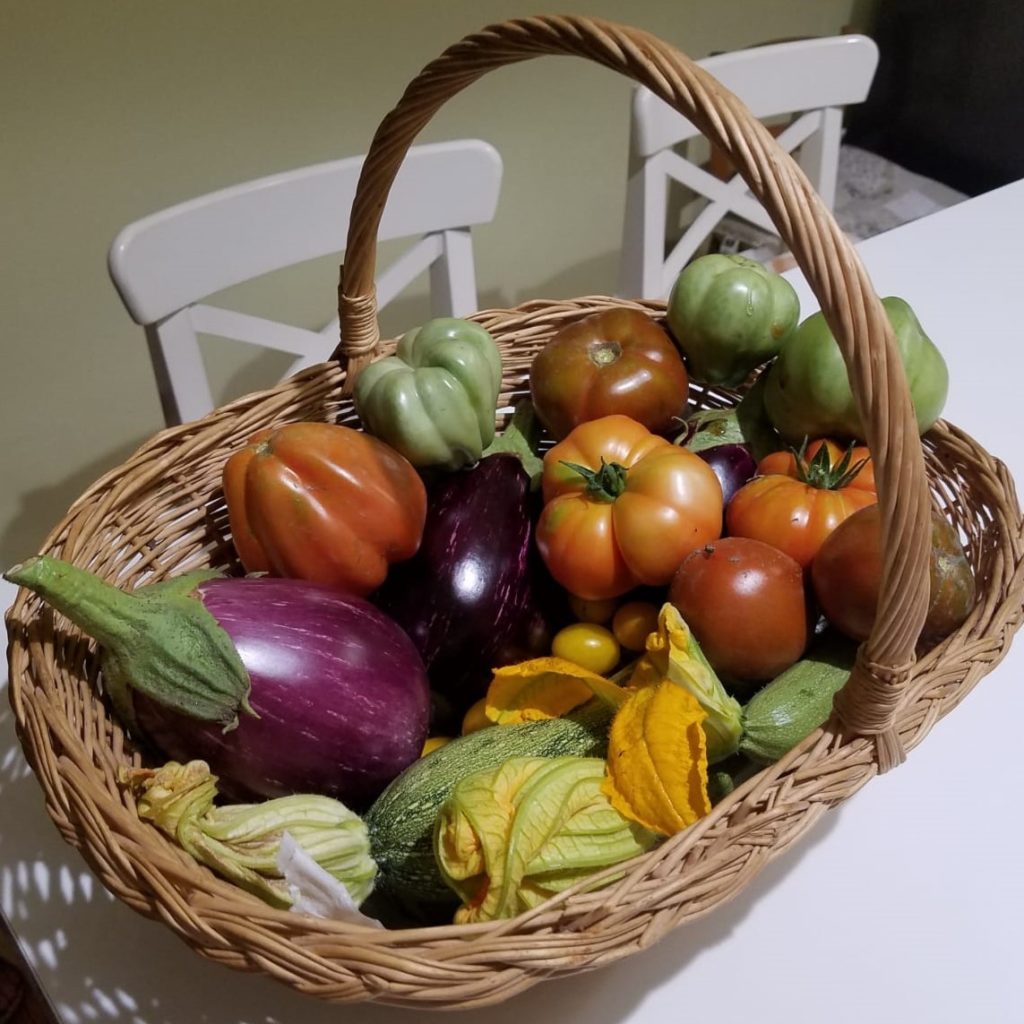
Sitting on the counter waiting for me was a container of zucchini that Zia Fidalma had sautéed a few days earlier and the leftover Friggitelli peppers from the previous dinner. My task was to make Frittata for lunch. We were trying to have a light lunch as we were going out to dinner in the courtyard of the church in Benabbio.
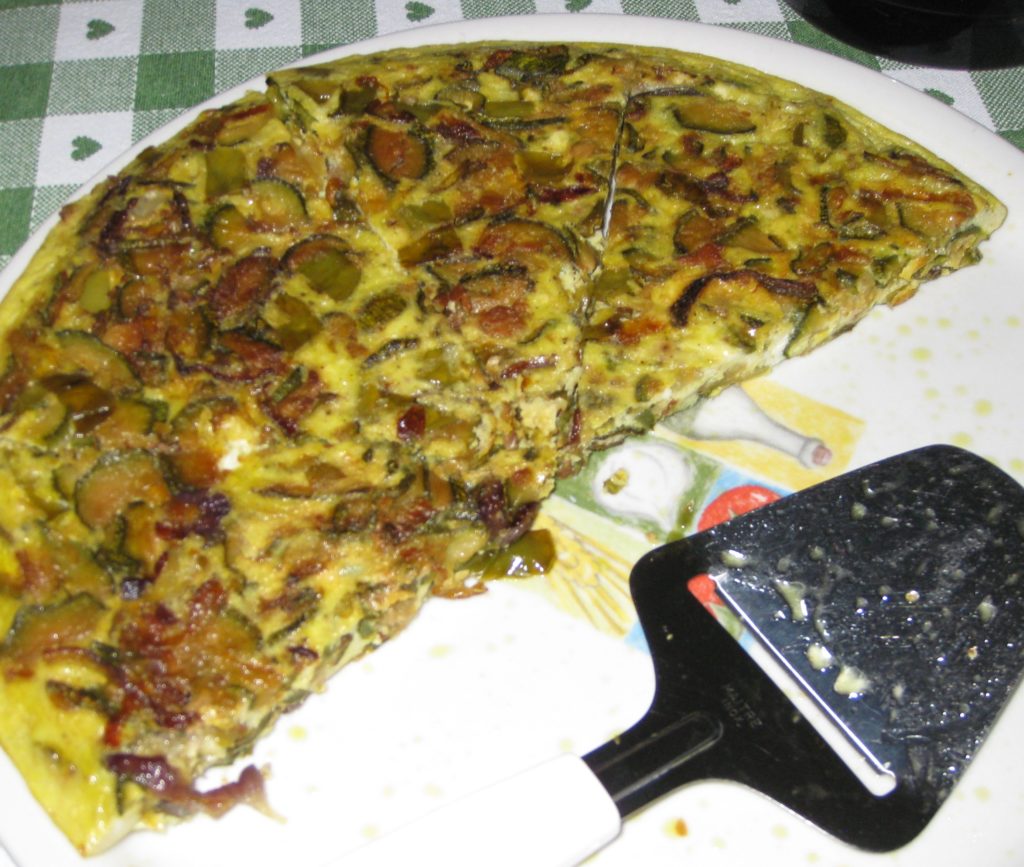
The occasion was a dinner hosted by Lucchesi nel Mondo (Luccans of the World), an organization to which my father-in-law and Zia Ida both belong. The branch of Lucchesi nel Mondo in Chicago (where we once lived) hosts regular dinners for members. The objectives of the overall association, with representation on “every continent” according to their website (though I tend to question the presence of a branch on Antarctica), is to make visits to communities around the world where there are many Lucchesi and to welcome Lucchesi who live abroad when they return to Italy. The dinner on the 11th was precisely one of these events to welcome returnees.
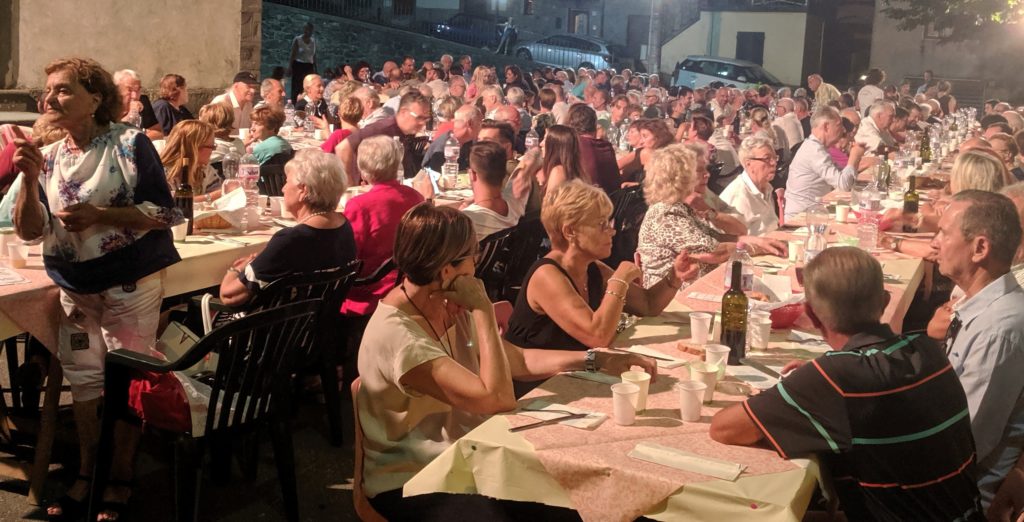
There were about 200 people in attendance. Several small exhibitions were set up in Benabbio, including one on key families put together by cousin Massimo that was housed in the local theater that is being restored. Another was in the former gelateria and focused on the family who ran the gelateria and on the many Lucchesi who were involved in setting up gelaterie around the world. One of the pictures of the gelateria in Benabbio shows an old gelato machine that I believe is an Effe, a company that is still in existence and that makes excellent gelato batch freezers (as the machines that freeze gelato are called).
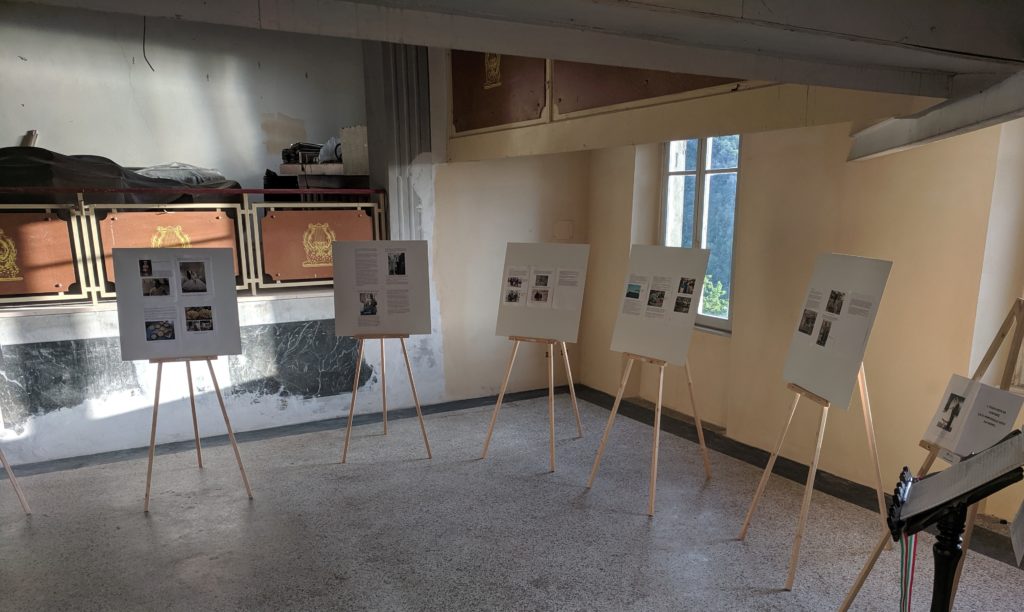
It’s a good thing that we went light on lunch. The dinner was very well prepared by Benabbio locals. It consisted of:
Aperitivo
Asti accompanied by potato chips (seriously!)
Antipasto
An assortment including crostini, cheese and apple, olives, and a rolled and sliced frittata
Primo #1
Tortelli al Ragu
Primo #2
Risotto ai Funghi Porcini
Secondo
Arrosto di Maiale
Cipolle Agrodolce
Sformato di Zucchini e Fagiolini
Dolce
Gelato
Caffè
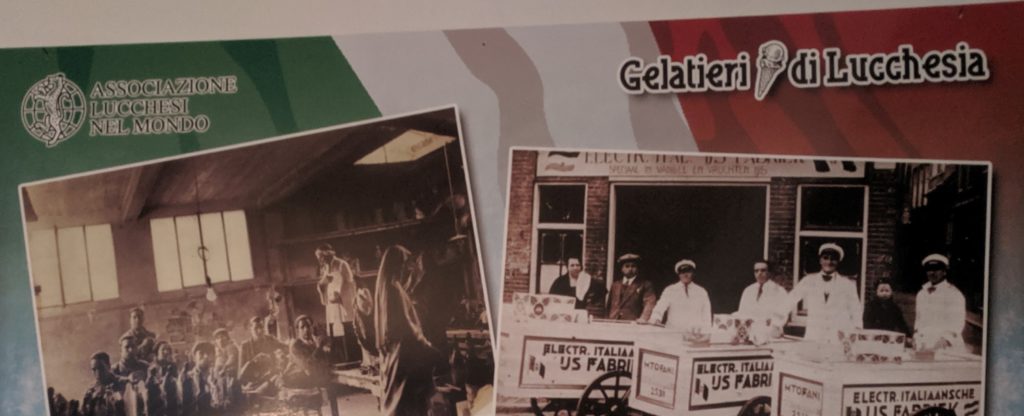
I decided to leave my car in Benabbio so that I could drink freely. Massimo drove me to the apartment and then returned home. It was disco night: the LOUDEST and LARGEST disco night yet. Streets were closed. Massimo dropped me off several streets away from my apartment due to street closures. Disco night ended at 3 AM but, since the DJ and lights were set up on the terrace of the adjacent apartment, there was the din of equipment being hauled out of the building from 3 AM to 4 AM.
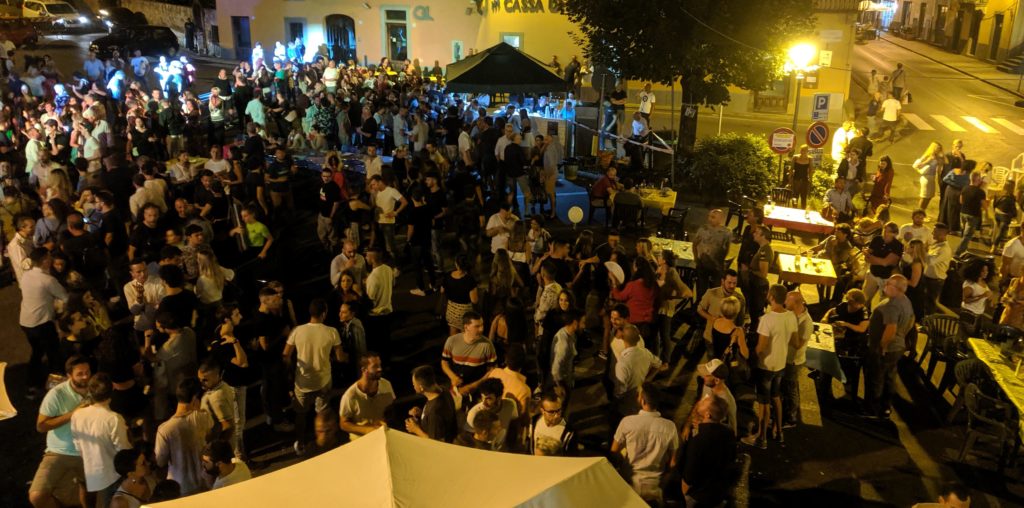
Zia had scheduled Roberto, Il Tassista, to pick me up in Bagni di Lucca on Monday morning and bring me to Benabbio. We met at the taxi stand about 45 minutes after the scheduled time (not my fault), he seemed a bit surprised but we set off. Roberto speaks Italian and, I gather from his repeated questioning about my language ability, passable French. We were limited to Italian but since I wasn’t planning on a long conversation with him it seemed OK as I knew I was able to negotiate the basics of our transaction adequately.
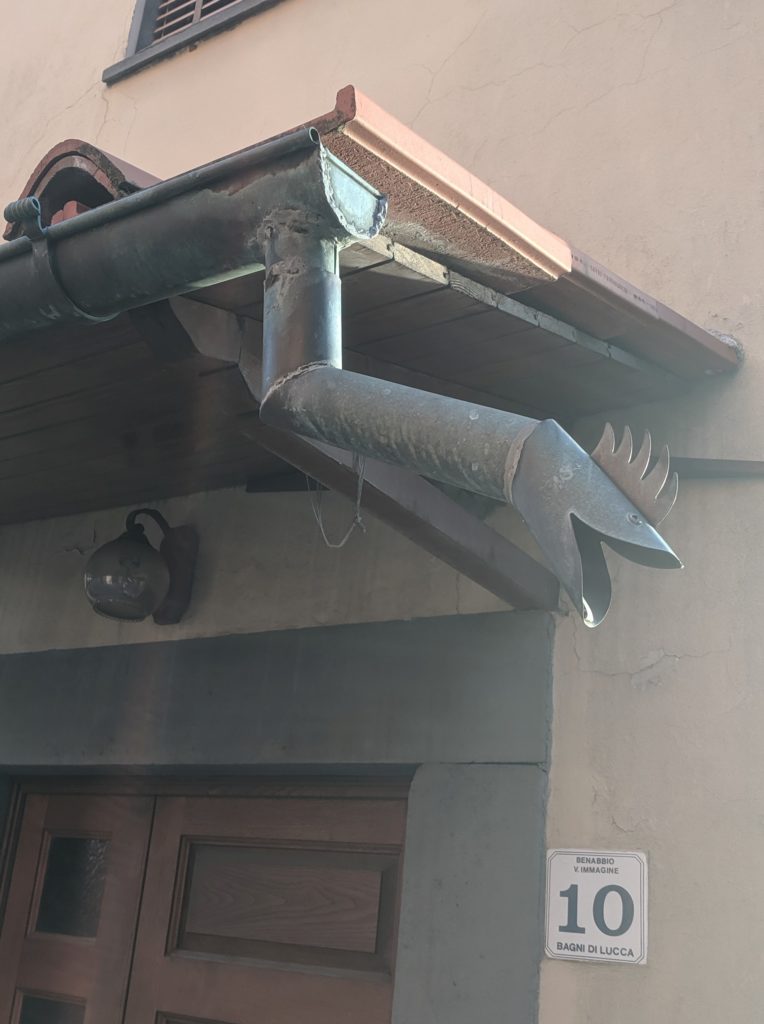
Part way up the mountain Roberto decided to pull over to show me the language app on his phone. He pulled across the road and just slightly out of the lane of oncoming traffic. Mind you, my side of the car was jutting out into the “lane” of the oncoming traffic. I use the word “lane” lightly as the road, in most places is not more than 1½ car widths’ wide. Unconcerned about our precarious position, he took quite a few minutes to demonstrate his app. It was pretty cool, but not cool enough to risk a head-on collision. Mercifully we set off again.
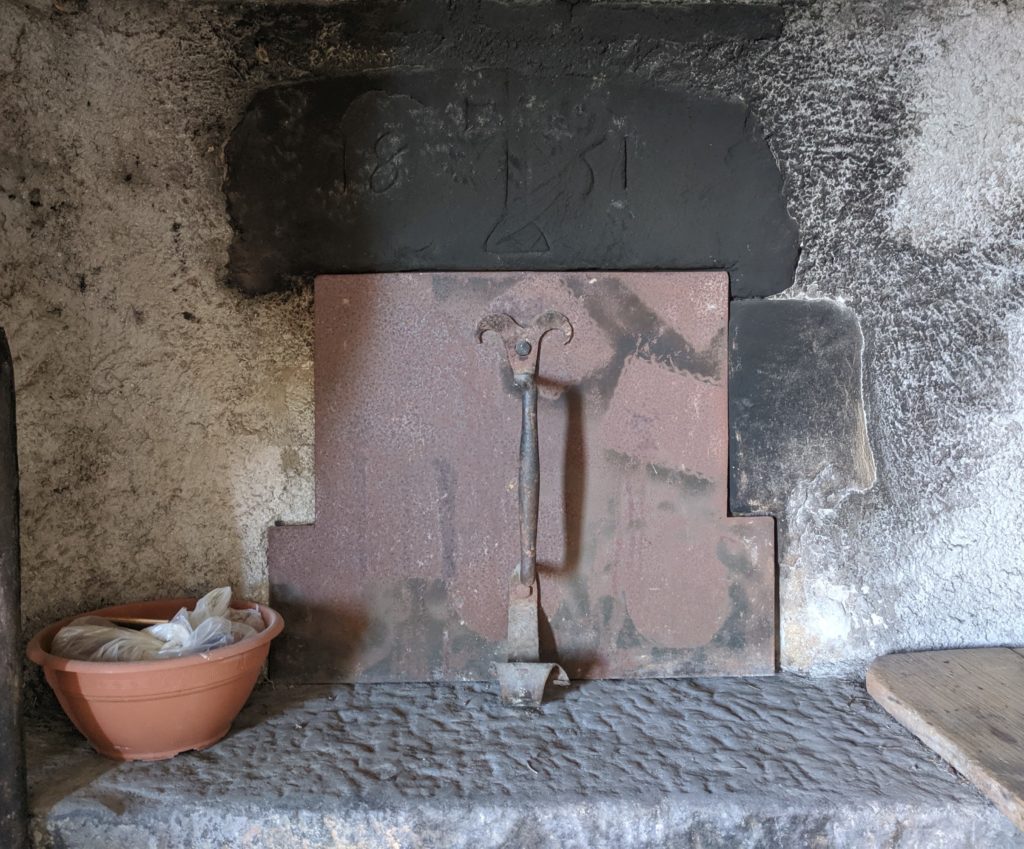
Not much later, he started to talk about a historic war between, I believe, Lucca and Pisa, pointing out the mountain occupied by the Pisans. The Luccans occupied the one we were navigating. The story of the war was told in a word salad of Italian and English. A few words of Italian, a word or two of English, a few words of Italian, a word or two of English. It was almost impossible for me to follow as I never knew when he was going to change languages (which was almost always). In addition, since words were not enough, Roberto frequently illustrated his story with his hands—both of them. This caused the car to veer across the road into oncoming traffic or in the other direction towards the sheer drop-off.
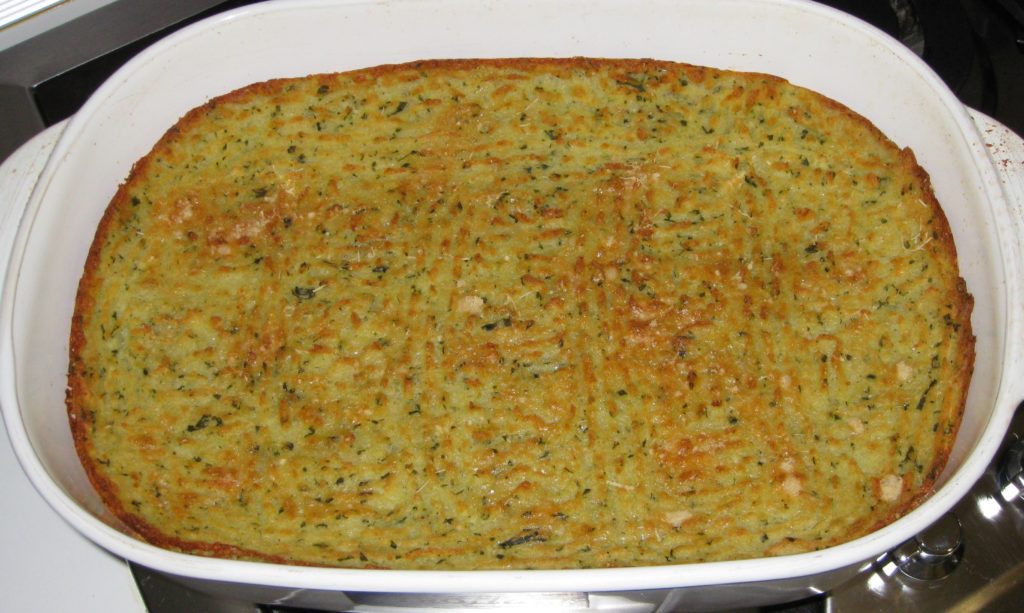
Once in the town of Benabbio, the adjacent peak was not easily visible, so the discussion of the war ended. Roberto then veered onto a side road, under a stone overpass to show me a stone carved with a date in the Tenth Century, a testament to the age of the town. He backed into the “gauntlet” and continued into the piazza of Benabbio where he introduced me to his wife who was carrying a load of empty boxes. We continued towards Zia’s house, stopping briefly so he could point out his garage, a proud possession (see below). Roberto safely deposited me near Zia’s house and was on his way.
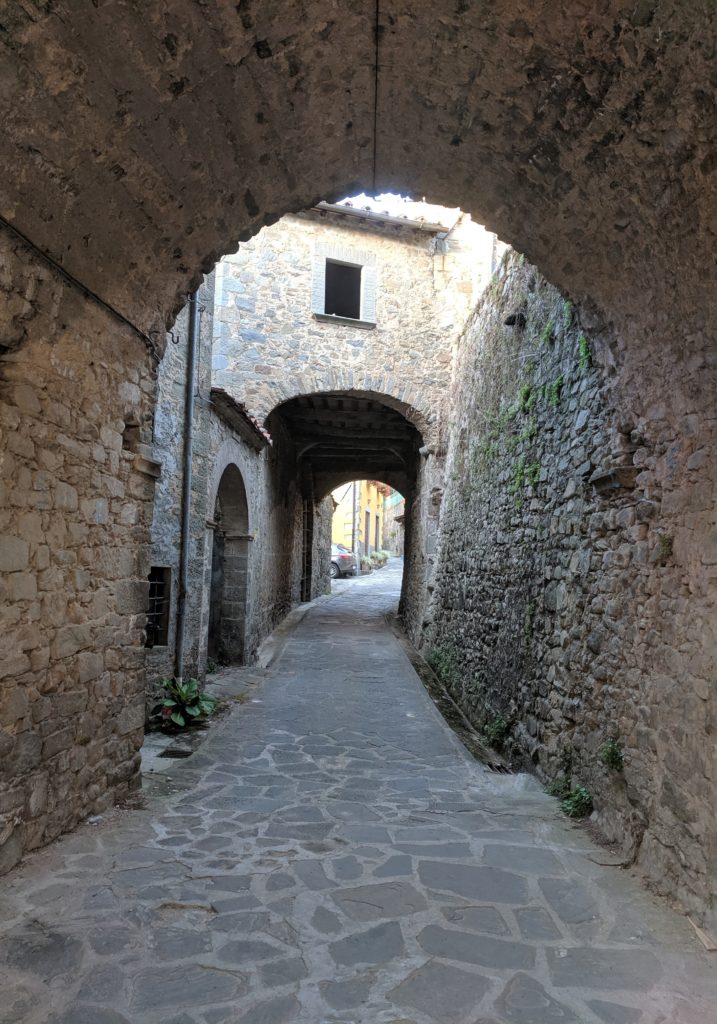
The rhythm at Zia’s house is that most of the cooking and prep work that can be done in advance is done in the morning. Monday morning was no different and we set about cooking.
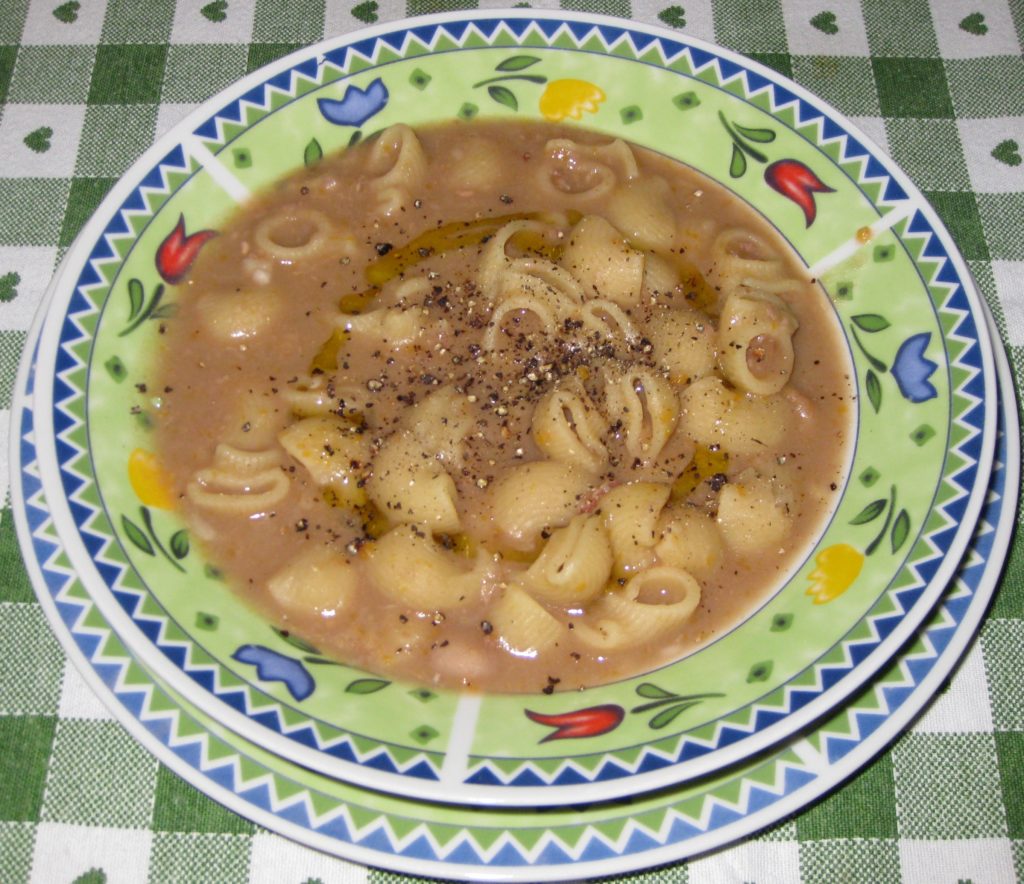
Before getting seriously into prep, however, we went to view a home in Benabbio that has recently been put up for sale. It is a large property with two kitchens, a living room, a sitting room, four bedrooms, two bathrooms, two cantine (storage cellars, one for wine and one for cured meats and other foods) and an upstairs storage room (with gorgeous views) used to store things like potatoes and apples through the winter. That’s the main house.

There is a two-story stone barn that opens to a massive garden on the edge of the mountain. There is also a building that houses the wood-burning oven. Originally all the supplies that were needed to make bread were kept in this building. Attached to the front is a greenhouse that serves as a limonaia (a place to winter-over lemon trees). There is also a GARAGE, a very rare occurrence in Benabbio. It is being sold completely furnished. We’d only need to bring toothbrushes.
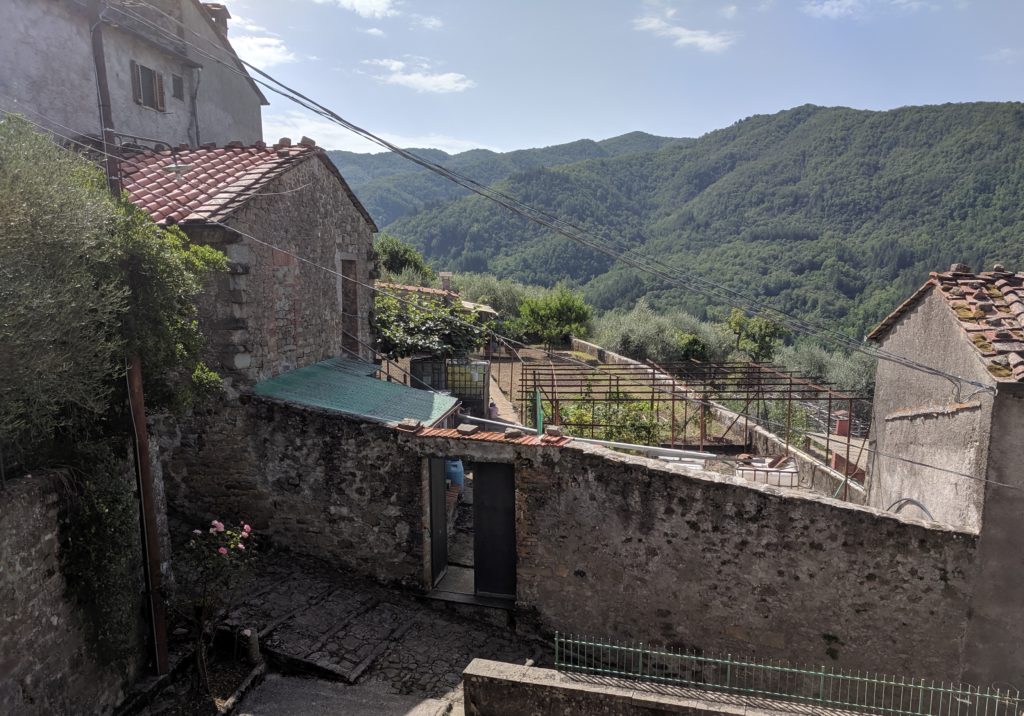
The second kitchen would be a great place for me to teach summer cooking classes in Tuscany. The upstairs sitting room would make a perfect dining room for the students when we’re not dining al fresco in the garden area overlooking the entire valley and the distant tall mountain peaks. Unfortunately, the biggest problem is bringing our dogs to Italy each summer. There are definitely airlines that allow pets in the cabin on international flights but it would be challenging for them given the length of the trip.
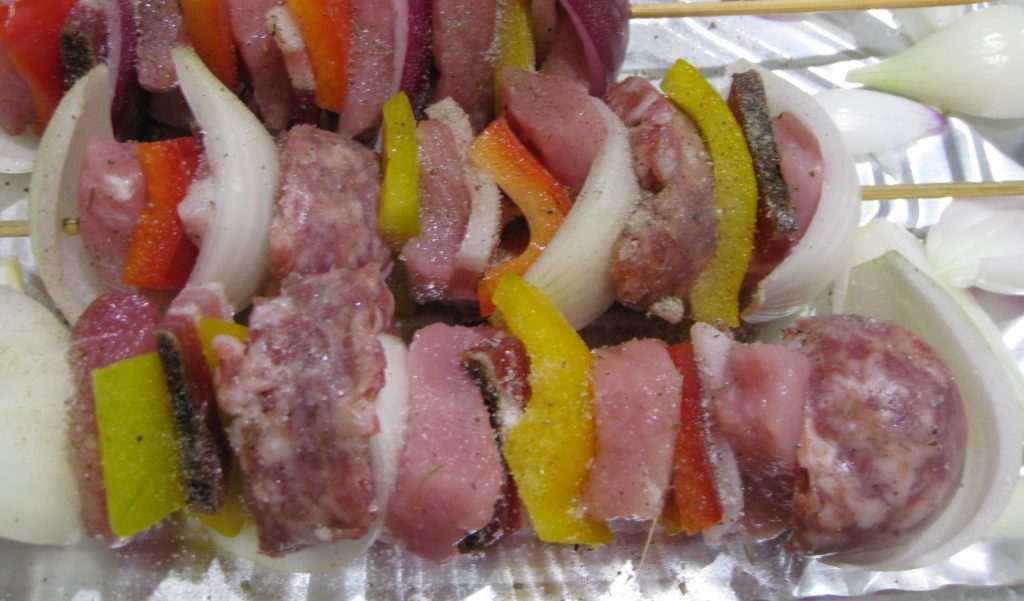
With the real estate excursion completed we set about assembling Spiedini for dinner. We filled little bowls with thinly sliced Pancetta Tesa, cubes of lean pork loin, sliced sausage, chunks of sweet red and yellow peppers, and pieces of red and white onion. We threaded them on skewers, seasoned them and refrigerated them till it was time to cook them.
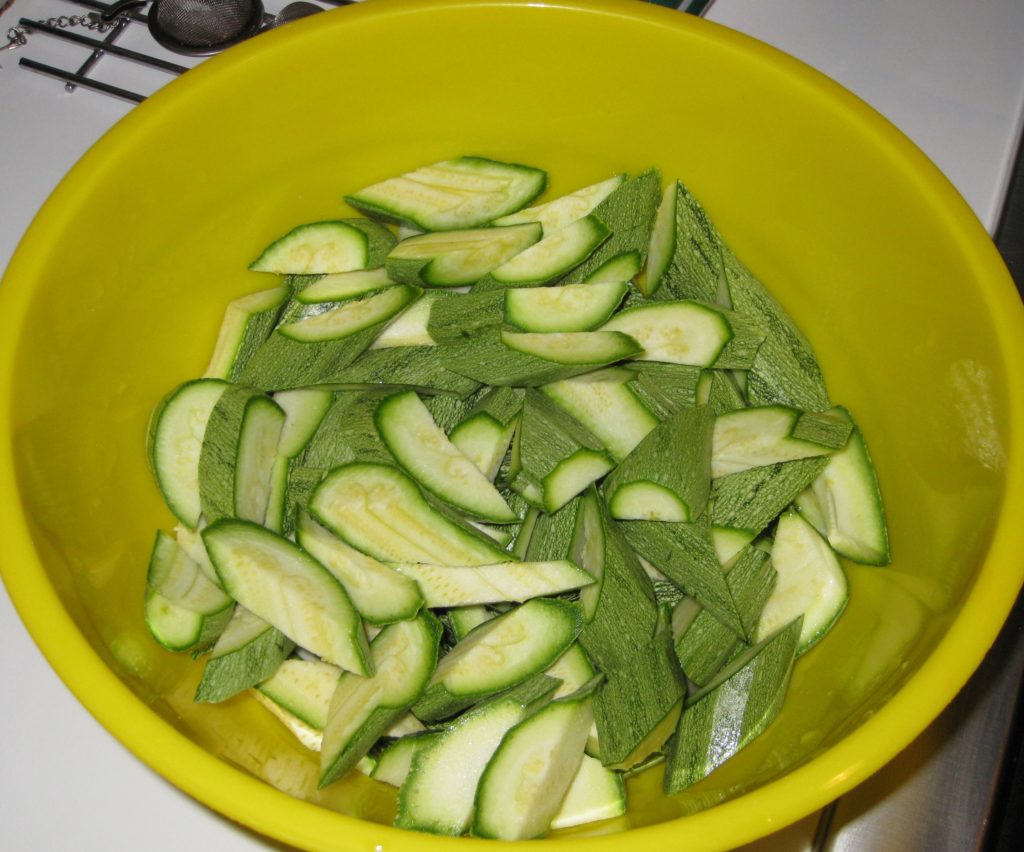
Cousin Francesca joined us for dinner. Zia whipped up a Risotto al Zafferano as a first course. That was followed by the Spiedini and a salad. Macedonia di Frutta was offered for dessert. I left before dessert, wanting to get down the road before it got dark. No doubt I will make the nighttime passage at some point but no need to do it more often than absolutely necessary.
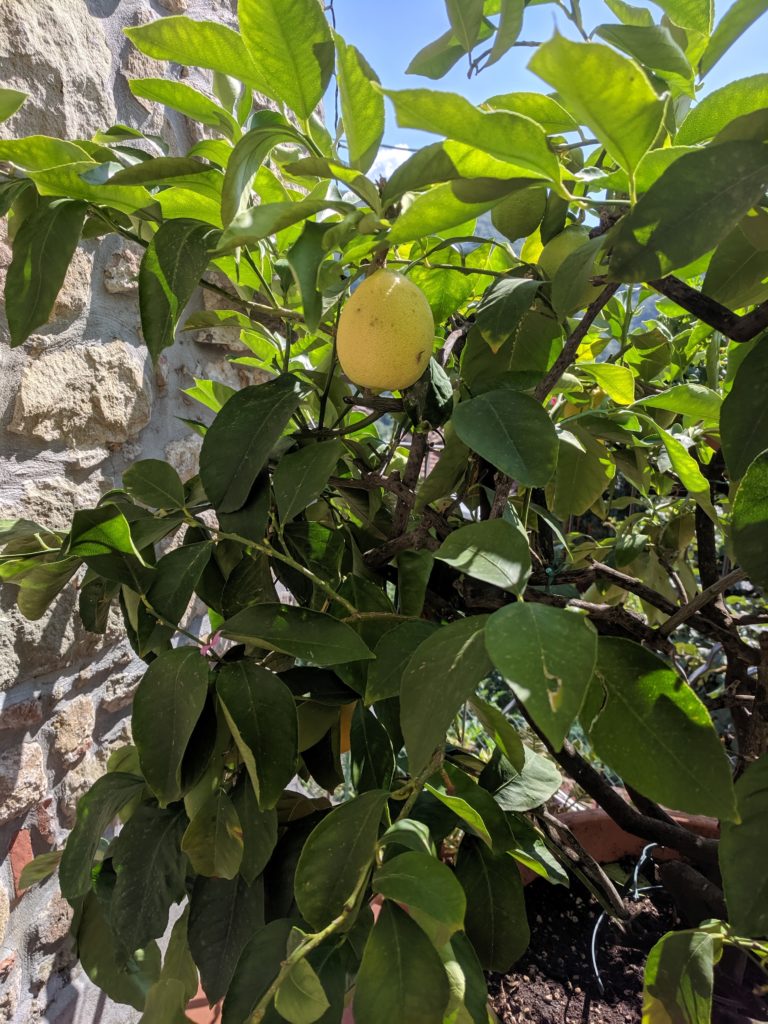
By the time I got to Zia’s the next morning, and mind you it wasn’t late, she had already harvested the garden and then started the Minestra di Fagioli (bean soup) for dinner, cooked the potatoes for the Torta di Patate slated to be our lunch, and cut up the Finocchio that would serve as the contorno (side dish) at dinner.
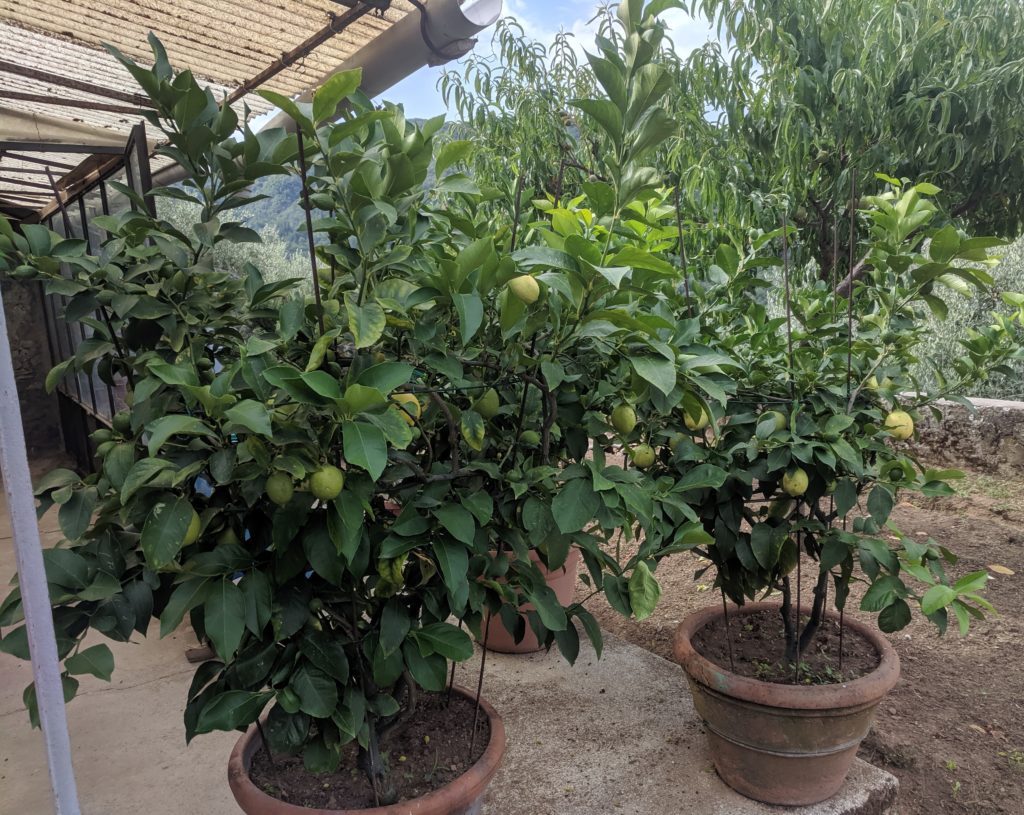
Torta di Patate is a wonderful dish for potato and carbohydrate lovers. It consists of boiled, riced potatoes seasoned with garlic and parsley. A little butter is mixed in and the whole mass is spread out in a buttered baking dish and baked until brown. An egg can be added if desired for a firmer texture. Accompanied by sliced tomatoes from the garden and a little Strachino cheese, it made a satisfying lunch.
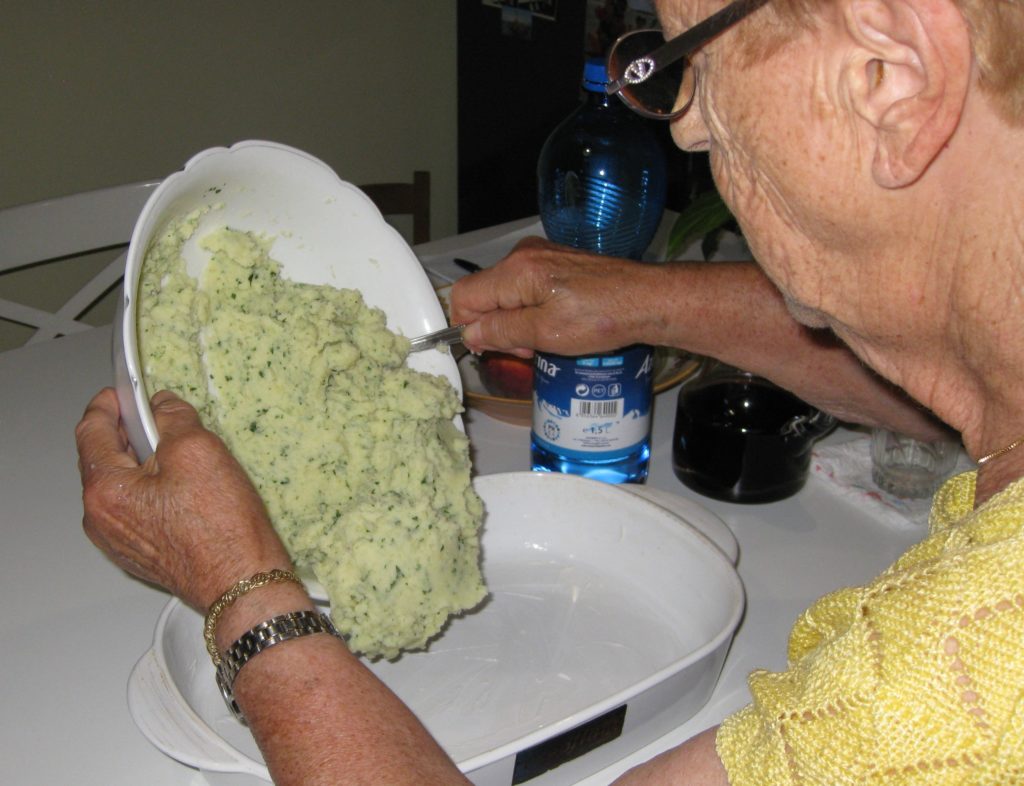
Zia’s Minestra di Fagioli is legendary. I had it when I visited in March and I made it for the first big dinner party I had after returning to the States after my three months at the Italian Culinary Institute earlier this year. After the soup, we had a secondo that consisted of some of the beans that had been cooked but not pureed into the soup accompanied by cooked Finocchio dressed with oil, salt and pepper and the leftover Torta di Patate.
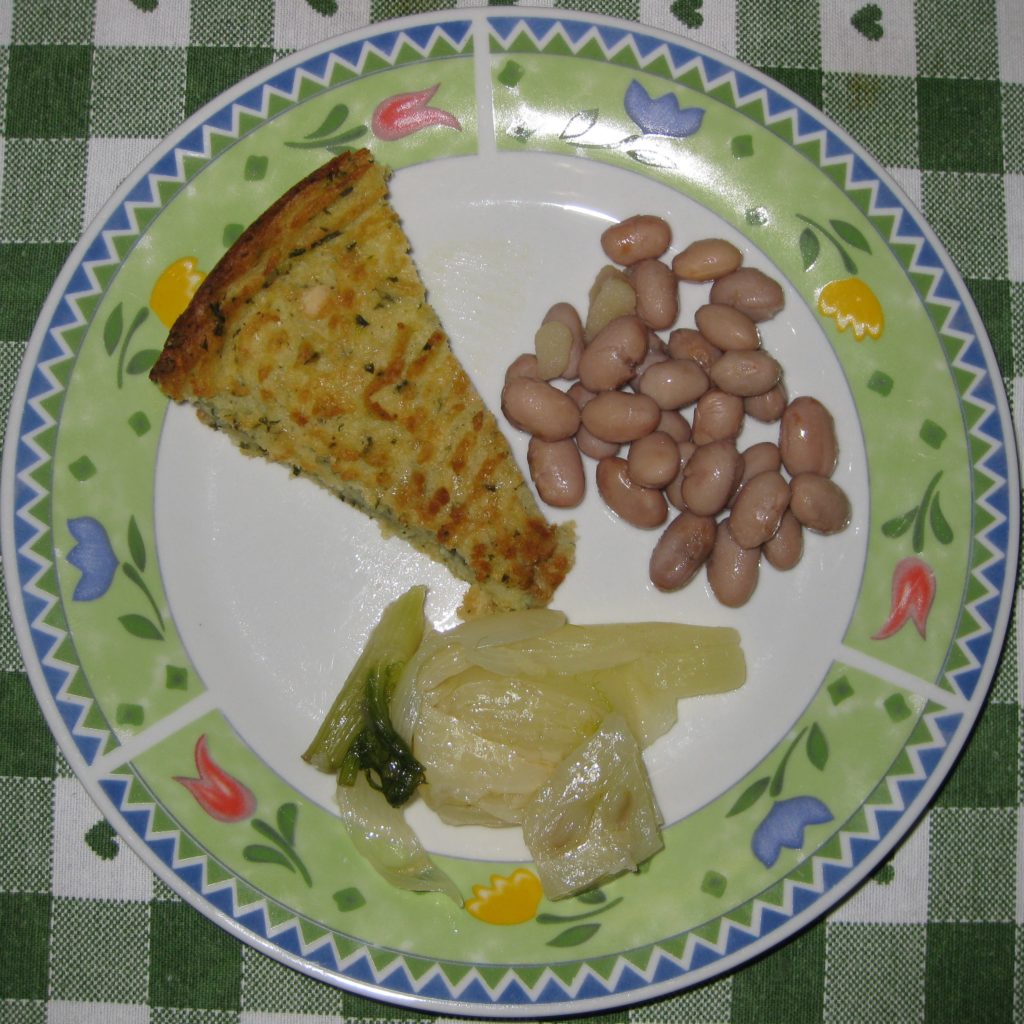
Once again, I headed down the mountain before dark, sated as always and wondering what cooking adventures the next day would bring.
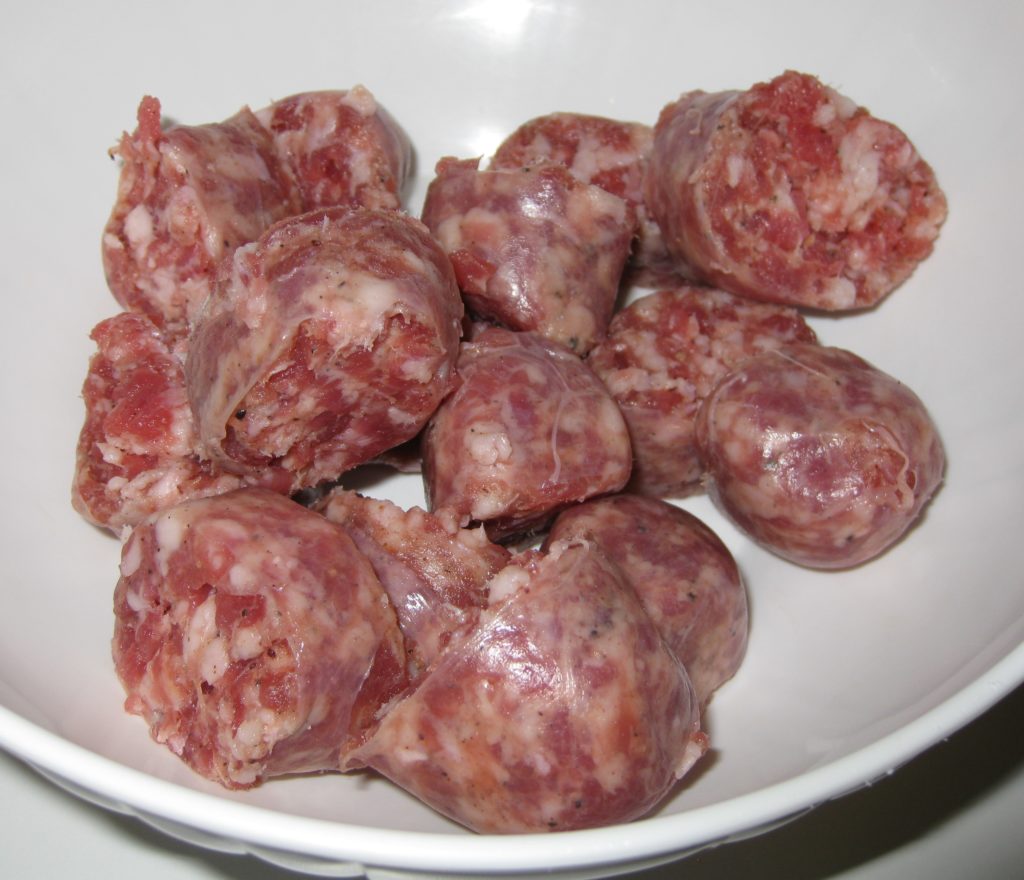

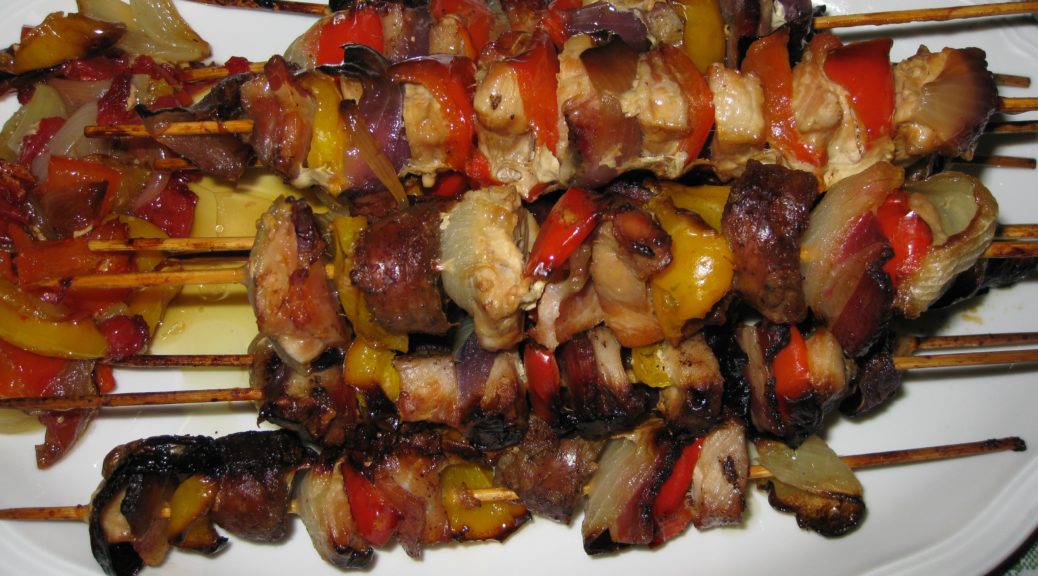
Curious the price of the home?
It’s listed at €160,000.
👍 fantastic read! What an adventure-thanks for sharing.
You are so very welcome!!
Oh Gary, I cringed and laughed and trembled reading about the taxi experience.
Wonderful being in the small towns and in Zia’s kitchen and I’m taking notes on all these beautiful dishes just beyond yummy…
I am soooooo jealous. There are lemons on the “trees” that are in pots—and the “trees” look really good. My trees, in the ground and lovingly cared for, have no lemons and while much taller, don’t look as full and good as the potted ones.
I’m sorry about your lemon trees. I know a house in Tuscany that we can buy. It comes with lemon trees and a limonaia as well as a two-story barn, a four-bedroom two-kitchen house, a stone building with a wood-burning oven, and a large garden.
That house has an absolutly stunning view and the town looks so beautiful! Also that Minestra di Fagioli looks delicious. Every time I read these I crave pasta.
The views in Benabbio can be absolutely incredible! Pasta is good. I heartily endorse pasta cravings. I’ll cook pasta for you any time!
Hello Gary! I have just found your infectious site. It is delicious. Thank you for all the work.
I was in search of a recipe for homemade passata di pomodoro, as evangelized by my friend Rolando (his, however, is uncooked… curious…).
You wrote in that passata post (exactly two years ago today!) of the canestrini tomato:
**********
“The canestrini, an heirloom variety, are grown from seeds that we brought back from Italy about 20 years ago. They were given to us by my husband’s Great Uncle Faliero (Great Aunt Fidalma’s husband).”
and you conclude with
“The taste, however, is superior.”
**********
Then, having decided it is right and proper to crawl down the Villa Sentieri rabbit hole, the very next blog post I open is this “Cooking in Tuscany #5.” And LO! there in the first image of the Zia Fidalma harvest basket is a tomato that looks suspiciously like the one I now covet from the first post I read…. and LOOK! The names are almost the same — Great Aunt Fidalma -and- Zia Fidalma….. but WAIT! GoogleTranslate confirms Zia = Aunt…. OH WOW! And there she is, wife of Uncle Faliero, the beneficent donator of the original canestrini seeds…. Aaaahhhhhh. I love a good story, a history.
I also love to cook. And I grow tomatoes. And I combine the two when Michigan weather allows (which means right now). But I have an abundance of paste tomatoes this year (mostly plain ol’ generic Roma, and Signore Beramendi’s jars of passata di pomodoro (with a single basil leaf) came to mind. So I searched for a recipe and found…. you! YAY!
While I do make cheese for Zingerman’s Creamery here in my retirement, I am in no way a professional cook. And I don’t play one on TV. But I do, in fact, do a lot of cooking. It is therapy for me. And I must need lots of help.
My go-to preference has always been Italian, and I am frankly in awe of your site/work. Much of what little I’ve seen in your posts so far is out of my range of experience, or even my cookbooks. (Please note: I traveled many times to Italy back when I was an engineer — 1985 to 2015. I even lived in Milano for some months in ’96. And I always ate and drank well.) But it all looks amazingly delicious, and so I look forward to future trips down the VS rabbit hole. Thank you in advance for all the inspiration.
–and–
Now, I am wondering if you, or perhaps your Zia, would share 10 or 15 genuine Canestrino di Lucca seeds with a humble story/history loving cook from Georgia who is stuck with SE Michigan zone 6a.
I ask because
a) I love a good story, and would have one, si?; and
b) as I’ve been writing this comment to Tuscany #5, I’ve looked for a US source for these canestrini seeds, and have not felt… comforted… Either the photo accompanying the seed page is completely wrong. Or the provenance for the original seed seems questionable. Or something…
And really, no matter what, what I really want to have and grow and talk about and share with my friends and family is the canestrini tomato from Gary Mihalik’s husband Frank’s Great Zia Fidalma in Lucca. How cool would that be?
Sooooo…. what do you think? Thanks for reading this far down, and any consideration you give to my request/suggestion.
ciao ciao,
~Allen
Hi Allen,
Sorry for the delay in responding. I will see what the situation is with Canestrini seeds when I get back to the States. How many we have depends on how good the harvest was and I haven’t been there to know. If it is at all possible, I will share some seeds with you. Unfortunately, your message came after I had left Tuscany for a month in Calabria so I was not able to get seeds from Zia Fidalma.
I am glad you are enjoying the blog. You may have noticed from Facebook that I was making a cauldron of Passata at the home of one of the employees of the Italian Culinary Institute in Calabria.